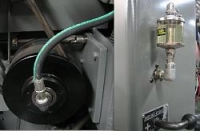Hi folks. I didn't find much mention of an answer in a search, so here is my current question:
I have one of these brass and glass Needle Valve Sight Gravity Drip Feed Oilers, which has a 1/8" MPT at the delivery end. Rather than experiment and re-invent the wheel, I am wondering if any of you have used these for dripping cutting oil on a lathe, mill, saw, etc. and can tell me what size, what material, and how small a diameter tubing one can use on these and still get a decent drip feed. I want to rig it up with a magnetic base mount (I have a couple extras not in use) so I can stick it on my lathe or mill, and use it to drip cutting oil on the cutter as it is working. I think a small diameter tube, something I can bend, position, and re-bend without kinking or breaking would be ideal. Would one of the "Cardan Joint" bendable tubes (looks like little plastic bowls stacked against each other) like they use on pump cutting oil systems work for a drip feed?
I've also got some 1/4" PEX tube, but its rather stiff. I think small copper refrigeration tubing would bend OK at first, but eventually work harden and get brittle. That's why I thought getting a Cardan Joint tube, with the small nozzle on it, would make things simple for adjustment. I just don't know if they are too small to gravity drip cutting oil.
Any suggestions are appreciated.




 LinkBack URL
LinkBack URL About LinkBacks
About LinkBacks



 Reply With Quote
Reply With Quote




Bookmarks